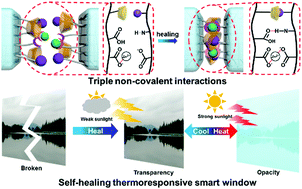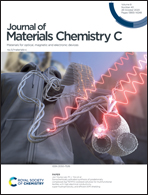Construction of triple non-covalent interaction-based ultra-strong self-healing polymeric gels via frontal polymerization†
Abstract
Self-healing polymeric gels have drawn great attention due to their promising practical applications. However, self-healing gels usually suffer from poor mechanical strength and versatility, which greatly limits their practicality. Here, we designed poly(NIPAM-co-MAH-β-CD-co-ZDA) gels (NIPAM = N-isopropylacrylamide, MAH-β-CD = β-cyclodextrin grafted vinyl carboxyl acid groups, ZDA = zinc acrylate) via frontal polymerization (FP). Benefiting from the triple non-covalent interactions (carboxyl–Zn2+ coordination, host–guest interactions and hydrogen bonding interactions), the products possess excellent self-healing (healing efficiency up to 95%) and mechanical properties (tensile stress of 1.41 MPa). The high mechanical strength and the self-healing and thermoresponsive properties allow the successful construction of a novel and versatile self-healing thermoresponsive smart window, which can greatly enhance the feasibility and practicality. Our work offers a facile pathway to fabricate high-performance polymeric gels through the integration of multiple non-covalent interactions, which act as a promising candidate for versatile smart windows.



 Please wait while we load your content...
Please wait while we load your content...